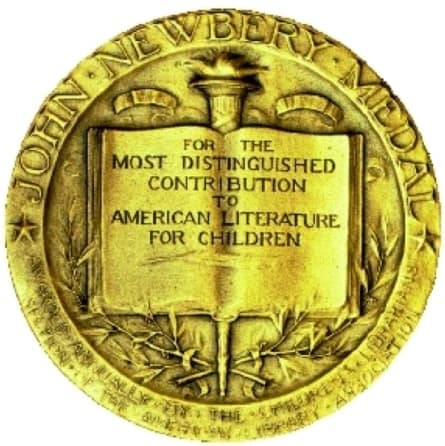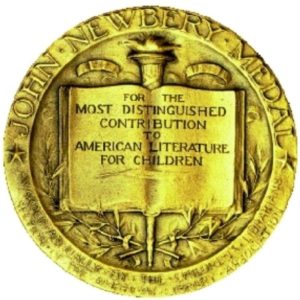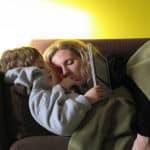Author Archives:Kate Tigue

3
OctFriends Forever: In Life and In Picture Books
 At this busy time in my life, I’m starting to realize the true importance of friendship even though I have never had less time to devote to it. My closest group of friends are three women who I’ve known since I was six years old. We’re fortunate enough to have weathered many storms together, even though we’ve been physically separated for over 20 years. After we left our beloved Catholic K-8 school, we all attended different high schools and colleges. I moved away from my hometown in New York to permanently settle here in suburban Boston. Another woman in our group moved to Pennsylvania. Yet thanks to modern technology and social media, we’ve kept in touch and are closer than ever as support one another on the journey of motherhood.
At this busy time in my life, I’m starting to realize the true importance of friendship even though I have never had less time to devote to it. My closest group of friends are three women who I’ve known since I was six years old. We’re fortunate enough to have weathered many storms together, even though we’ve been physically separated for over 20 years. After we left our beloved Catholic K-8 school, we all attended different high schools and colleges. I moved away from my hometown in New York to permanently settle here in suburban Boston. Another woman in our group moved to Pennsylvania. Yet thanks to modern technology and social media, we’ve kept in touch and are closer than ever as support one another on the journey of motherhood.
My best friends have taught me that I need three things to make friendships last through adulthood: laughter, forgiveness, and support. The mysterious balancing act of balancing work, motherhood, and being a wife and daughter can be overwhelming. Laughing our way through the difficult things with my friends is the only thing that keeps me from running away at times. Whenever we get together or talk on the phone, tears are guaranteed, not because we are crying but because we make each other laugh until we cry. Laughter truly is the best medicine and the world feels right again once I’ve been laughing with my friends.
My second key friendship value is forgiveness. Life is moving very quickly for me these days. In a rush of school drop-off, activities, working, weekend plans, cooking, tidying, and the occasional date night or two, I know I often neglect relationships outside of my family. I need my friends to forgive me for forgetting to call them back or not sending a thank-you note. I don’t make enough effort to drive down to my hometown to see my friends now that my parents aren’t living there anymore. I’m probably going to let you down if you have rigid social expectations, not because I’m rude or don’t care but because I am usually exhausted and often forgetful. Luckily, my best friends are right there with me in the struggle and never judge me if I have to postpone our phone chats because I’m dealing with a sick kid or a homeowner crisis.
Finally, I need my adult friends to be supportive. Our adolescent days of talking uninterrupted on the phone might be over, but I always have time to shoot my friends a quick text or Facebook message. We have a Facebook group that’s our safe space to vent about our husbands and work, worry about our kids (as well as show them off) and share whatever is going on in our lives. That support is my lifeline through everyday ups and downs and it keeps our friendship current and accessible in a busy world.
Reading picture books aloud is one of the great joys of being a children’s librarian. Some of my favorites are those that focus on friendship. Not the overly saccharine texts that feature perfectly behaved people (or animals) but the real ones that show how mutual regard and affection can sustain two people (or animals) through life’s imperfections. Often, friendships in picture books have an “odd couple” quality that only adds to their charm.
The brilliance of George and Martha by James Marshall has set the standard for portraying friendship in picture books. These two delightful hippopotamuses are best friends who know each other through and through. George isn’t the most clever hippo and Martha often outsmarts him but he’s also joyful and supportive. He does frequently snoop through Martha’s things but she always forgives him. Martha can be a diva but she’s always a good sport. She can be ill-tempered but is quick to get over an argument. Nothing much ever happens in their stories but somehow James Marshall’s understated text and illustrations create their profound friendship. Other delightful George and Martha books include George and Martha: One Fine Day, George and Martha: Rise and Shine, and George and Martha: Back in Town.
Arnold Lobel created the classic Frog and Toad series, stories that show the everyday dramas and misadventures of America’s most famous amphibians. These two friends also have their ups and downs but are only really content when they are together. They often miss each other and wonder what the other is doing when apart. Neither of them are perfect though. Toad can be a little lazy and is self-conscious about how he looks in a bathing suit. Frog loves pulling pranks and loves horror stories even more. But each appreciates the other for who he really is and their stories teach children to value individuality over sameness in a relationship. Frog and Toad’s adventures are featured in Days with Frog and Toad, Frog and Toad Are Friends, Frog and Toad Together and Frog and Toad All Year.
Both George and Martha and Frog and Toad were written in the 1970s. No other picture book duo approached classic friendship status until Mo Willems created Elephant and Piggie. In Today I Will Fly, we are introduced to Gerald, a lovable but slightly neurotic elephant prone to meltdowns, and Piggie, a carefree, laid back pig with a playful side. My best friend, who is also a children’s librarian, declares that there are two types of people in this world: Geralds or Piggies. Willems clearly casts the pair as an odd couple with Gerald as a Type A rule follower and Piggie, who is cheerfully free and easy. It goes without saying that my friend and I are clearly Geralds. Gerald and Piggie solve all sorts of friendship problems like sharing issues, not liking your best friend’s favorite food, and what to do when the weather doesn’t cooperate with your plans. More riveting adventures can be found in all 25 volumes in the series.
These picture books reflect the complexities and wonderful realities of friendship. Our friends sustain us not only as we face the trials and tribulations of life but also through the everyday mundane details of living. The friends in these books hold up the ideal qualities of friendship while being imperfect animals. They accept and love their friends even when they aren’t their best selves. And that is the most enduring and satisfying thing about friendship in childhood and in adult life.
Kate Tigue is the Head of Youth Services at the Morrill Memorial Library in Norwood, MA. Look for her article in the October 3, 2019 issue of the Transcript and Bulletin.

29
NovBook Nutrition: Different Ways to Feed the Brain
 Recently, the staff in the Children’s Room has been noticing a trend in children’s and young adult literature: lots of adults take out and read books traditionally written for young people. This is certainly because literature for kids is now being marketed more widely than ever before. Film producers and directors are mining the rich landscape of books aimed at children to find their next big hit on the silver screen. Some books almost seem to be written with the potential optioning of movie rights in mind. It’s no wonder with all that exposure that our collections in the Children’s room have received more adult attention.
Recently, the staff in the Children’s Room has been noticing a trend in children’s and young adult literature: lots of adults take out and read books traditionally written for young people. This is certainly because literature for kids is now being marketed more widely than ever before. Film producers and directors are mining the rich landscape of books aimed at children to find their next big hit on the silver screen. Some books almost seem to be written with the potential optioning of movie rights in mind. It’s no wonder with all that exposure that our collections in the Children’s room have received more adult attention.
We’ve also noticed authors blur the traditional boundaries between audience and genres. In years past, publishers would help authors focus on what group of people their books were for and in what specific genre their story ideas would fit. More than ever, book plots defy categorization and we end up reading reviews for the next “paranormal historical mystery with a dash of suspense.” These types of unique plots make for a more interesting read and attract more adult readers.
Most importantly, children’s librarians are starting to see a division in the tone of children’s literature. In prior decades, children’s books were written with kids in mind but an author’s prose and themes were often held to adult fiction standards. Madeleine L’Engle’s “A Wrinkle in Time” explores a universal coming-of-age story, but well-written characters and fully developed motifs helped adults engage in this classic novel. In more recent times, there are definitely books that were published with a child audience in mind and speak to directly to how kids really feel and experience reality. Jeff Kinney’s “Diary of a Wimpy Kid” series seems to mirror exactly how kids react when faced with tough ethical decisions. Children respond to Greg Heffley, the flawed main character – the book’s humor and lack of preachy adults to correct bad behavior. Many adults cringe at the lack of moral fiber in these titles but they have also turned so many children into readers that it’s hard to dismiss the power of reliability.
In contrast to Diary of a Wimpy Kid, books like Kate DiCamillo’s “Raymie Nightingale” and “Louisiana’s Way Home” are seemingly marketed to children but have an adult, reflective tone to the narrative. Both novels center around twelve year old girls who experience the loss of an adult family member and changes to the family structure while figuring out what it means to transition from the innocent world of childhood to the more challenging reality of adulthood. Both of these books are beautifully written with poignant characterization and dialogue, but I just don’t think most actual twelve year old girls can actually reflect on their circumstances as maturely as Raymie and Louisiana do. Many children experience the family difficulties both girls endure, but few are able to come to the self-possessed realizations and forgiveness both girls find at the end of their stories. Simply put, adult perspectives are masquerading as unrealistic growth in a juvenile protagonist. It should come as no surprise that both books received rave reviews and awards, but most kids bypass them and head straight to other series that meet them where they are.
There is nothing wrong with either approach in children’s literature, and they each serve a different function. Stories that reflect the true inner emotional life and secret wishes of children will always have a strong pull for most young readers. These books are the sweet treats of the book world; they are sugary, appealing, and go down easy for most kids. Books that have a little more emotional depth and meatier, more complex themes are the good nutrition we feed to kids to help their brains and moral imagination strengthen and grow. These stories stick with kids and are great for reading with others and re-reading as kids grow up. We are more forgiving with adult reading choices, and if we can understand the different purposes and audiences that children’s books can reach, we might be more understanding with kids as well.
Kate Tigue is the Head of Youth Services at the Morrill Memorial Library in Norwood, MA. Look for her article in the November 29, 2018 edition of the Norwood Transcript and Bulletin.

5
JulYA: For Teens or Adults?
 One of my favorite responsibilities as a youth services librarian is choosing new young adult books to purchase for the library’s expanding collection. Young adult books (or YA as we say in the library world) is one of the most well-known and fastest growing literary genres in this decade. Most people learn about young adult books through the popular trend of adapting their plots for the silver screen. Recent films like Ready Player One, The Hunger Games trilogy, and The Fault in Our Stars have turned public interest to the books these movies are based on and sparked adult interest in books intended for adolescents.
One of my favorite responsibilities as a youth services librarian is choosing new young adult books to purchase for the library’s expanding collection. Young adult books (or YA as we say in the library world) is one of the most well-known and fastest growing literary genres in this decade. Most people learn about young adult books through the popular trend of adapting their plots for the silver screen. Recent films like Ready Player One, The Hunger Games trilogy, and The Fault in Our Stars have turned public interest to the books these movies are based on and sparked adult interest in books intended for adolescents.
“Young adult literature” is a rather amorphous term that is challenging to define and seems to change every few years. Originally, “YA” came into its own as a bonafide literary sub-genre sometime in the 1950s and 1960s, when novels intended for adults had realistic settings and focused on the issues adolescents were facing at the time. J.D. Salinger probably didn’t intend for Catcher in the Rye to be a massive hit with teens when he published it in 1951 but it’s almost exclusively read as a part of high school curricula and categorized as YA in many library collections today.
By the 1960s, authors were beginning to write specifically with a teen audience in mind. S.E. Hinton wrote her famous YA benchmark, The Outsiders, about teens in rural Oklahoma in 1965 when she was still in high school herself. Hinton cited her dissatisfaction with the state of literature that was considered appropriate for teens at the time as her main inspiration for writing her own YA novel.
Young adult literature really came into its own in the 70s and 80s. Many of the classics of that era are still influential for YA authors and readers today. Books like Forever by Judy Blume and The Chocolate War by Robert Cormier, took an unflinching look at the intense social drama and sex lives of high schoolers. More YA authors began to experiment with the thriller genre for teens, producing hits like The Face on the Milk Carton by Caroline B. Cooney and the Remember Me trilogy by Christopher Pike.
In the past 20 years, young adult fantasy and science fiction novels have been a staple for readers, libraries, and bookstores. The popularity of series like Twilight and The Hunger Games brought young adult literature to the center stage and movie adaptations have drawn more public interest and more publishing dollars to the genre. YA literature has become so popular that adults are taking notice once again. Many libraries host young adult books clubs for adults and we see as many adult patrons checking out YA books as we do teens.
I must confess I’m an adult reader of young adult literature. Part of it is professionally driven as I purchase all the YA books for the library’s collection and run the young adult book club, Books ‘n’ Bites, but it’s also rooted in personal enjoyment with a dash of escapism. Because of the age of the protagonists, YA offers us a way to go back and remember that feeling of endless possibility before the permanence of adult choice and responsibility settles in.
One of the great joys of being the facilitator of the Books ‘n’ Bites YA book club is listening to teens explore and critique the tropes of young adult novels. Many of them love the emphasis on strong female characters and delight in the idea that young people’s actions can change and even save the world. However, they are equally critical of the romantic entanglements that seems to pop up in nearly every YA title. For example, we recently read Eliza and Her Monsters, a modern story of a creative high schooler who publishes her own enormously successful web comic. The titular character not only has to deal with the pressures of continuing to create under the spotlight of success, she also has to cope with living two separate lives: one online, on in the real world. Book club members thoroughly enjoyed those themes but were extremely critical of Eliza’s unhealthy and disturbing relationship with a new boy at her school who derails her success.
There are signs that YA publishing juggernaut is slowing down. A recent conversation with a coworker, a mother of two teens, reminded me of a cardinal truth of adolescents: as soon as adults catch on to something teens love, teens immediately reject it and move on to something else! My coworker’s daughters were already expressing their desire to read adult literature simply because they were sick of how formulaic and predictable YA books have become. In the last two years, books aimed at 18-24 year olds have been gaining popularity. This new sub-genre is called New Adult. Will New Adult experience the same explosion as YA has in the past 20 years? Maybe. Or maybe we’ll all remember that the only thing that marks a particular titles for a particular audience is marketing.
Kate Tigue is the Assistant Children’s Librarian at the Morrill Memorial Library in Norwood, Massachusetts. Read Kate’s column in the July 5 issue of the Norwood Transcript and Bulletin

15
FebThe Battle for the Newbery Award
 “If something bad is happening to a child in a book, that book will win the Newbery”, a veteran children’s librarian complained to me once. And I can’t deny it. Next week, the Association for Library Services to Children (ALSC) will announce the winner of the John Newbery Medal, a highly coveted award for best contribution to American children’s literature in the past year on Monday, February 12, 2018. The winner is selected by a committee of children’s librarians from across the country and broadcast at the American Library Association’s Midwinter conference.
“If something bad is happening to a child in a book, that book will win the Newbery”, a veteran children’s librarian complained to me once. And I can’t deny it. Next week, the Association for Library Services to Children (ALSC) will announce the winner of the John Newbery Medal, a highly coveted award for best contribution to American children’s literature in the past year on Monday, February 12, 2018. The winner is selected by a committee of children’s librarians from across the country and broadcast at the American Library Association’s Midwinter conference.
The original idea behind the Newbery medal was cited by Fred. G. Melcher as a way to boost publishers’ interest in producing children’s literature in the 1920s. At the time, there was a growing interest in stories for children that didn’t necessarily have a moral or didactic purpose. British authors like E. Nesbit (The Railway Children) and A. A. Milne (Winnie the Pooh) and Canadian author L.M. Montgomery (Anne of Green Gables) had begun to whet the public’s appetite for more humorous, child-focused stories. The award was named for John Newbery, a prominent 18th century British publisher and called the “father of children’s literature” for publishing the first book directed at a juvenile audience, A Pretty Little Pocket-book.
Melcher himself was the editor of Publisher’s Weekly, an industry trade magazine, and was well-versed on how to utilize publicity to boost the sales and peak interest. Today, we’d say that he created “buzz” around children’s literature by creating an award for it and asking its largest buyers, children’s librarians, to form a committee of judges to grant the honor. Since 1922, members of ALSC, then called the Children’s Librarians’ Section of ALA, have met on a yearly basis to decide which meet the award criteria.
At first glance, the three criteria seem deceptively simple: the Newbery Award can be granted to an American author who has written the most distinguished contribution to American children’s literature. The author must reside in the US and the book must be published in English by an American publisher. Seems pretty easy, right? Just pick the best book, right? Well, as the years have gone on and the committee structure has evolved, the three original criteria remain but definitions have been added in an attempt to tease out exactly what we mean by “distinguished”. What does it mean for a book to be the best? ALSC defines distinguished children’s literature as books that are marked by “eminence and distinction, noted for significant achievement, excellence in quality and are individually distinct”. I’m not sure if that makes things any clearer!
What has become clear in the past 20 years is a growing dissent among librarians about what kind of books SHOULD win the Newbery Medal. Many of us have observed that the Newbery Medal winners aren’t terribly popular with their intended audience: children! For those of us who work with kids on a regular basis, selling the most recent Newbery winners to kids as an enticing read is a real challenge. The settings and characters appear to be getting more and more obscure and the point of views are more seemingly adult rather than from a child’s perspective. This was not always the case. Many of us remember the golden era of the 1990s that produced classics like Maniac Magee by Jerry Spinelli (1997), Number the Stars and The Giver both by Lois Lowry (1990 & 1994), and Holes by Louis Sachar (1999). All of these are staples in any children’s literature collection and are frequently requested by actual children!
The 2008 Newbery Committee selected Good Masters, Sweet Ladies: Voices From a Medieval Village by Laura Amy Schlitz, a book that became a lightning rod for the controversy over “good books” winning instead of popular books. Schlitz’s book comprises of a series of individual narratives of fictional medieval village inhabitants, similar to Chaucer’s Canterbury Tales. Certainly, this winner would qualify as “individually distinct” but left many librarians wondering if kids would be attracted to the subject matter.
Noted children’s literature scholar Anita Silvey wrote a controversial piece for School Library Journal, a popular review journal for school and public librarians, where she wondered whether the Newbery Award had lost touch with real kids. Silvey noted that many librarians, teachers, and book critics felt the same way, feelings that might possibly prevent them from purchasing the next Newbery winner. This seems to be antithetical to the original purpose of the award, to bolster public and professional interest in and sales of children’s literature. Finally, Silvey concluded that while the award’s selection criteria don’t include consideration of how children themselves would receive the winner, the concepts of popular books and quality literature should not be mutually exclusive.
I completely agree with Silvey’s point. I recently read last year’s winner, The Girl Who Drank the Moon by Kelly Barnhill and, while I thoroughly enjoyed it as an adult reader, I was left scratching my head over what type of child I could actually convince to check it out of the library. The story focuses on a magical village at the age of the forest that requires one child to be set out in the woods as a sacrifice for the local witch. Barnhill’s clever narrative alternates between the witch and one of the children left out in the woods. It’s a wonderful book and I highly recommend it…to other adults. I don’t think many children would stick with the first half of the book which follows the witch and her philosophical musings on her life’s purpose, her role as a parent, and her own impending death. While many children certainly have some understanding of these topics, I don’t think they could relate to it from an adult perspective.
The Newbery Award is an amazing opportunity to drum up excitement over reading for children. The current digital era provides ton of distractions for kids and furthers the the desire for instant gratifications. This makes the challenge of finding good books akin to finding good-tasting healthy food kids will eat instead of junk. If children’s librarians, educators, and parents truly want reading to be a preferred activity for kids, we have to feed them a diet of great but palatable literature to make them want more. Given that over 20,000 children’s books are published in America annually, we should be able to expect that the highest literary achievement in that field can reward an author that combines both well-written, insightful thoughts wrapped in a story to which kids can connect. By the time you read this, the 2018 Newbery Award winner will have been announced. Let’s hope it doesn’t disappoint.
Update: The 2018 Youth Media Awards were announced on Monday, February 12, 2018 at the ALA Midwinter Conference in Denver, Co. Hello, Universe by Erin Entrada Kelly is the recipient of this year’s John Newbery Medal. More on the rest of the award winners here.
Kate Tigue is the Assistant Children’s Librarian at the Morrill Memorial Library. Read her column in the Thursday, February 15, 2018 edition of the Norwood Transcript and Bulletin.

11
MayBooks in the Time of Exhaustion
 Every expectant mother goes through a period of anxiety when she imagines what life will be like after the baby arrives. Will anything be the same? It’s one of those rubicon moments that you can’t totally fathom until it happens. Most of us realize that life will never be the same once a child enters the picture but understanding the enormity and permanence of that change can take some time to process.
Every expectant mother goes through a period of anxiety when she imagines what life will be like after the baby arrives. Will anything be the same? It’s one of those rubicon moments that you can’t totally fathom until it happens. Most of us realize that life will never be the same once a child enters the picture but understanding the enormity and permanence of that change can take some time to process.
One of my chief worries during pregnancy about life as a new mom was wondering how I would keep reading. Compared to concerns about the baby’s health, it’s a little trivial but reading is my only lifelong hobby. I’ve never been dedicated to crafting or outdoor pursuits or any other recreational activity. Reading has been one of the constants in my life since childhood and the one thing I truly love to do. Like many moms-to-be, I was trying to figure out how I could hang on to some small part of myself during an intense life change.
Now that I’m almost four years into this parenting gig, I can say two things for sure: 1) I’m surviving and 2) I still read. Of course, my life looks very different to the one I lived before motherhood. Do I read as much or as often as I would like? No way. I used to be able to juggle reading multiple books without missing a plot point and could remember my place in all of them without deigning to use a bookmark. I used to read for hours at a time. I could read for more than twenty minutes without falling asleep. And I certainly never woke myself up by dropping a book on my own face. I don’t know that life anymore.
But I’ve made some adjustments and figured out how to keep reading as a parent. Here are my top tips to you keep reading when you feel like you’re too busy running after little ones or carting around older kids!
- Lower your expectations: This is decent advice for all areas of life once a baby arrives on the scene. You will not be able to read like you once did. You may not be able to read every day. You may have to change what you read or when you read. If you expect your reading life to remain unchanged, you are wrong. Allow me to phrase it as our Disney overlords do: “Let it go! Let it goooo!”.
- Get the right equipment: Buy an e-reader. I know many of you book traditionalists will roll your eyes or try to resist. But using an e-reader or a tablet is truly the most convenient way to read as a parent. Firstly, e-readers and tablets are extremely lightweight and allow you to read one-handed, a necessity when your baby won’t let you put him or her down. In addition, these devices have backlighting so you can comfortably read in the dark, perfect for late night feedings or marathon “will you stay with me until I fall asleep” sessions with older kids.
- Change up your format: If you’re in the car a lot, either commuting to work or waiting for kids at activities, try books on CD or downloading e-audiobooks to your phone. You can turn your drive or wait into productive reading time! If you download or stream e-audiobooks on your phone, you can also make the most of nap time or housework and listen to a book with your headphones while you get things done. The library currently provides e-books and e-audiobooks through our Overdrive catalog and Hoopla streaming service.
- Change your style: Maybe your tastes run toward Tolstoy or Dickens or sweeping fantasy sagas with hundreds of characters. You might need to consider shorter, lighter reading material. I’m not saying parenthood kills off your brain cells but it certainly consumes most of them and you may not be able to remember all the Game of Thrones plotlines as accurately as you did before kids. If reading has become a chore or too much a challenge, you won’t do it.
- Give yourself a break and try something new. Maybe it’s time to explore some short story collections or tear through a fast-paced thriller. Maybe it’s time for something light, something that gives your brain a vacation. Or, perhaps, you can go with the kid theme and re-read some childhood favorites or read some of the recent Newbery Award winners. Reading kid-lit can also give you an idea of what your child might be reading in the future or give you ideas of books you can share together as they grow up. Whatever you do, put those parenting books down! They’ll only make you feel bad and you need a break from the anxiety of parenting small kids.
- Set a goal: I have my husband to thank for this one. He’s a very disciplined person who finds it easier to create a habit by setting a hard and fast goal rather than just hoping he’ll read more. He reads ten pages from one novel in the morning and another ten at night. It’s not a huge commitment but this habit has allowed him to read twenty books a year, a feat for any parent. Setting a goal can keep you focused and force you to tae time for yourself as you develop a new reading habit.
- Find an excuse: Many parents, especially moms, can feel guilty about taking any time for themselves. When you find yourself feeling guilty for taking time to read, remember that studies show children who SEE their parents reading usually become readers themselves and are more likely to engage in reading as a leisure activity as they get older. So by taking time to read, you are modeling the behavior you want your children to emulate.
- Make it fun: Join a book club or an online reading group. This gives you an excuse to read, get out on your own (sans kids), or at least be social. If you can’t get out, try joining GoodReads or another online reading challenge. Even using Facebook to ask for book recommendations will generate some great feedback and inspire you to get back to reading. If reading becomes a conversation point or a social outlet, you’ll be dying to get into your next book.
To me, reading is as essential to me as breathing. It’s both my escape and my way to understand the world around me. It is my lifeline to the rest of the world when my everyday life feels consumed by making mac ‘n’ cheese and potty training. It gives me something interesting to talk about with my husband and other adults. It keeps me sane and I hope it’s something I can get my daughter to love. My little one isn’t reading yet but I can only hope she gets as much enjoyment out of books as I do. And the only way that will happening is if I keep on reading!
Kate Tigue is the Assistant Children’s Librarian at the Morrill Memorial Library in Norwood, Mass. Read her column in the May 11, 2016 issue of the Norwood Transcript & Bulletin.
